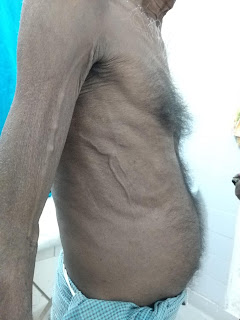Secondary Peritonitis due to a MISSED cause
Disclaimer:This is a HIPAA de-identified open-online-patient-record with patient information posted here after collecting informed patient consent.
65 yr old male, labourer by occupation, chronic smoker and
alcoholic came with complaints of:
Vomitings followed by abdominal distension associated with abdominal pain and shortness of breath since 20days.
Pedal edema G-2, pitting type, for a week which got subsided later.
Pedal edema G-2, pitting type, for a week which got subsided later.
Loss of appetite & constipation since 15 days.
History of presenting illness:
I
was apparently normal 20 days back then I developed vomitings 6 episodes in the evening containing
food particles and yellowish liquid after binge drinking (actually I gave up
alcohol for 3 months and now I had this country drink) followed by Abdominal
distention which I noticed the next day morning and it was associated with
abdominal pain which was diffuse below the my belly button and also difficulty in breathing. I also developed low grade fever, intermittent, subsided with sweating. then I lost my appetite and later constipation added to my problems. then after week i noticed my legs are swollen upto my knees, later i felt burning sensation while urinating (may be i was not taking enough water)
Personal history
Personal history
pt takes
mixed diet, decreased sleep and appetite due to pain and distension resp.
Sedentary lifestyle
Sedentary lifestyle
Chronic smoker 50pack years
Chronic alcoholic [since 35yrs] takes brandy
180ml/day.
Not a diabetic.
Not a hypertensive. No h/o previous surgeries
or BTs.
GENERAL EXAMINATION
Patient appears to be thin built
,undernourised, febrile.
• No Pallor
• Icterus present
• No cyanosis
• No kylonycia
• No lympadenopathy.
• Bilateral pedal edema present. G-2
pitting type.
• Disturbed sleep due to severe
abdominal pain.
• Bladder regular with burning
micturition, constipation present.
vitals: pulse 105bpm, BP 140/100, RR 22cycles/min, spO2 94
On examination abdomen distended with umbilicus everted, fluid thrill present,on auscultation basal crepts present.




vitals: pulse 105bpm, BP 140/100, RR 22cycles/min, spO2 94
On examination abdomen distended with umbilicus everted, fluid thrill present,on auscultation basal crepts present.




ROUTINE INVESTIGATIONS:
Ø HEAMOGLOBIN 11
Ø TOTAL COUNT 17400
Ø TOTAL BILIRUBIN 3.I
Ø DIRECT BILIRUBIN I.3
Ø ALBUMIN 2.3
Ø USG abdomen
: large loculated ascitis.
Ø CECT abdomen
: large loculated ascitis with bilateral pleural effusion,No signs of liver
failure.
ASCITIC FLUID ANALYSIS:
Sugar 56 (60-100)
Protein 3.6(<2.5)
Amylase 26
SAAG 1.5(<1.1)
Total count 4400cells/cumm
Neutrophils 90
Lymphocytes 10
Cultures isolated E Coli sensitive to AMIKACIN, GENTAMYCIN, MEROPENEM

 |
| Ascitic fluid aspirate growing E coli |
FINAL DIAGNOSIS
MASSIVE ASCITIS
? LIVER FAILURE.
? SPONTANEOUS BACTERIAL PERITONITIS
? SECONDARY BACTERIAL PERITONITIS
?FOLLOWING SEALED BOWEL
PERFORATION
UPPER GI ENDOSCOPY:
Hiatus hernia.
Bowel perforation was ruled out.
Liver failure was ruled out.
FINAL DIAGNOSIS: MASSIVE ASCITIS
? SPONTANEOUS BACTERIAL
PERITONITIS
So This was a case of a secondary peritonitis with perforation that was treated successfully with antibiotics and surgical intervention. Although the case did have certain characteristics of SBP, such as monomicrobial infection and improvement of absolute neutrophil count after 48 h of antibiotics, persistence of patient symptomatology prompted further evaluation to look for an alternate diagnosis. Runyon’s criteria have an estimated sensitivity and specificity for predicting secondary bacterial peritonitis of 67 and 96%, respectively and our patient met the criteria."Runyon’s Criteria for secondary bacterial peritonitis requires two of these three features:
total protein >1 g/dL, glucose <50 mg/dL (2.8 mM), and lactate dehydrodgenase above the upper limit of normal for serum."
http://emcrit.org/pulmcrit/secondary-bacterial-peritonitis/
So This was a case of a secondary peritonitis with perforation that was treated successfully with antibiotics and surgical intervention. Although the case did have certain characteristics of SBP, such as monomicrobial infection and improvement of absolute neutrophil count after 48 h of antibiotics, persistence of patient symptomatology prompted further evaluation to look for an alternate diagnosis. Runyon’s criteria have an estimated sensitivity and specificity for predicting secondary bacterial peritonitis of 67 and 96%, respectively and our patient met the criteria."Runyon’s Criteria for secondary bacterial peritonitis requires two of these three features:
total protein >1 g/dL, glucose <50 mg/dL (2.8 mM), and lactate dehydrodgenase above the upper limit of normal for serum."
http://emcrit.org/pulmcrit/secondary-bacterial-peritonitis/
That together with the lack of improvement prompted us to probe further. A repeat paracentesis is not necessary for all patients with infected ascites but should be considered in patients with one or more characteristics of secondary peritonitis as detailed above. Re-categorizing this case from SBP to secondary peritonitis allowed us to advocate for a likely curative surgical intervention.
as the patient is elderly malignancy was also suspected and cytology was done as shown in above slide image. No malignant cells were seen. The USG doesn't show any obvious malignancy.
SECOND ADMISSION:
Patient
presented with similar complaints of
Abdominal distention
Abdominal distention
Loss
of appetite with loss of weight. He lost about 10kg in a span of one month.
Sugar 36
Protein 1.5
SAAG 0.5
Counts 1300cells/cumm.
Cultures : isolated E coli
CECT abdomen with iv contrast was advised - SUSPECTED GALL BLADDER PERFORATION
pt was subjected to DIAGNOSTIC LAPAROSCOPY and GALL BLADDER PERFORATION was confirmed.
pt was subjected to DIAGNOSTIC LAPAROSCOPY and GALL BLADDER PERFORATION was confirmed.
FINAL DIAGNOSIS
MASSIVE TENSE ASCITIS secondary to GALL BLADDER PERFORATION [sealed]






Comments
Post a Comment